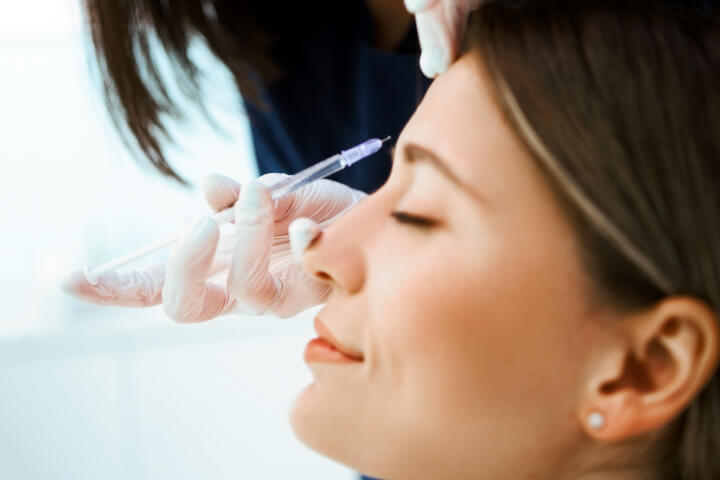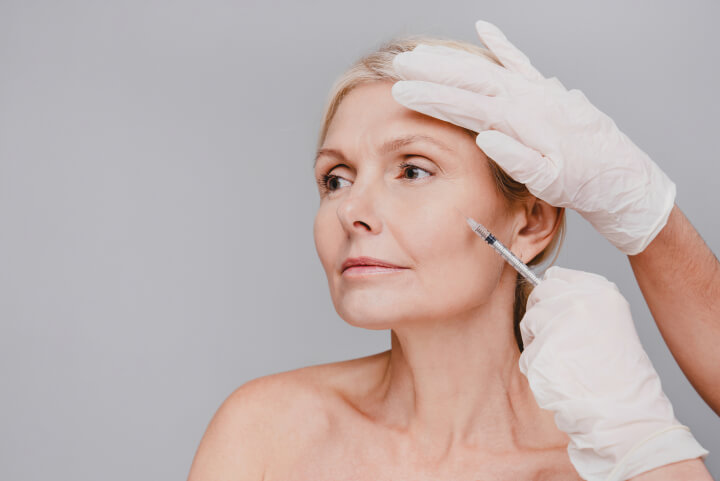
Dermal fillers are a possible cosmetic procedure you’ll want to consider for your wrinkles. Depending on the type of filler you get, you can see a fuller, healthier-looking face free of fine lines and wrinkles. For many, autologous fillers may seem like a good dermal filler type to choose, but people should do their research first before settling for a certain type of filler, and consider things like price and longevity.
So how much do autologous fillers cost per injection, and how long do they last? Autologous dermal injections are more expensive than other popular injectable fillers, as you’ll be shelling out approximately $2,508 for one syringe of autologous fat injections and $981 for platelet-rich plasma (PRP) injections.The great thing though is that these fillers show consistent results for over a year. If you’re considering fat or plasma as your wrinkle filler of choice, read below to know more.
Read More: How Do You Inject Small-Particle Hyaluronic Acid Dermal Fillers?
Aesthetica can assist you with all your beauty needs, helping you achieve your maximum beauty and aesthetic potential. Call or contact us today to learn more about our cosmetic services.
Out of all the dermal filler types available, two of them are considered autologous: fat grafting or autologous fat injections, and platelet-rich plasma (PRP) injections. Later on, we’ll discuss more about the differences between the two and which could be the better option if you’re considering more than just cost (which you should).
Based on the 2020 statistics by the American Society of Plastic Surgeons, you’ll be shelling out an average of $2,508 for one syringe of autologous fat injections, and $981 for PRP. Keep in mind that most patients require multiple injections to achieve their desired look, and then multiple sessions to maintain their appearance.
For reference, here are the average cost of dermal fillers in 2020 as found by the American Society of Plastic Surgeons:
| Dermal Filler Substance | Dermal Filler Brand | Average Cost Per Syringe |
| Hyaluronic acid | Belotero, Captique, Juvederm, Perlane, Restylane | $684 |
| Calcium hydroxylapatite | Radiesse | $717 |
| Polylactic acid | Sculptra | $853 |
| Platelet-rich plasma (PRP) | $981 | |
| Polymethyl-methacrylate microspheres (synthetic filler) | Bellafill | $1,058 |
| Autologous fat injections (fat grafting) | $2,508 |
Autologous fat injections are the most expensive option out of all the types of dermal fillers. However, it’s costly for a number of reasons.
First, the fat grafting is a common procedure not just for dermal fillers, but for other cosmetic surgical procedures. Fat is extracted from certain parts of your body and transferred to other areas like breasts, hips, butt, hands, and feet. To perform autologous procedures like fat transfers, a cosmetic surgeon will need to perform a liposuction and extract enough fat for the treatment. Liposuction is an invasive procedure, so the cost of an autologous fat injection also includes the cost of a liposuction.
Second, there’s the process to create your dermal filler out of your fat. After your doctor extracts your donor fat, it will undergo decantation, centrifugation, and processing. The result is purified fat that can be re-injected into your body. Aside from liposuction, the entire process of transforming your body fat into a dermal filler is a costly process.
And third, autologous fat is the most expensive type of wrinkle filler because it generally lasts the longest. Dermal fillers made from fat-grafting can be permanent. While not all the fat will remain on your face, most of the injected fat will remain in the injected area indefinitely.
In comparison, dermal fillers made with natural substances like hyaluronic acid can last up to 18 months, while synthetic fillers last longer because the body doesn’t absorb it. However, both natural and synthetic will need additional scheduled treatments to maintain your appearance and avoid wrinkles from returning.
But what about PRP injections? PRP injections are roughly around the mid-range of the different types of dermal fillers. Based on the American Society of Plastic Surgeons, the cost of one PRP injection is more expensive than fillers made with hyaluronic acid (Juvederm, Restylane, Belotero) at $684 per syringe, but not as expensive as fillers like Bellafill that can cost around $1,058 per syringe. In total, expect to spend between $500 to $2,500 for PRP injections.
Autologous fat and plasma dermal fillers are good options, but you shouldn’t be choosing the type of dermal filler you use based on price alone. It’s best to also consider your desired results and the most practical choice to help you achieve them.
For instance, a hyaluronic acid filler is the most affordable option, but this doesn’t necessarily make it the worst choice. If it’s your first time getting dermal fillers, you might want to consider hyaluronic acid fillers first to see the results, see how it can affect your lifestyle (in terms of proper aftercare), and determine if dermal fillers are right for you. On top of this, hyaluronic acid can provide added benefits such as increased collagen production.
That’s why it’s best to consult with a dermatologist or plastic surgeon first and weigh out the possible filler types.
Learn More: Red or Dark Spots on the Lips After Lip Filler: Why You Have Them and What to Do About It
As we mentioned earlier, autologous fat injections are permanent. Not all the injected fat will survive, so your cosmetic surgeon will overfill the treatment area and your body will dissolve and distribute the filler into a more natural appearance.
PRP injections, on the other hand, can last between 18 months up to two years, depending on a number of factors including your aftercare practices. That’s why if you want to maximize your PRP injections, ask your doctor about maintenance and care and see if you can adjust your lifestyle habits and practices to prolong its efficacy.
Aside from autologous fat injections, dermal fillers can be semi-permanent or temporary. Over time, substances like hyaluronic acid are natural in the body and can metabolize over time. A couple of ways to prolong the effects of your fillers include:
Read More: How Long Do You Have to Wait After Fillers And Botox to Get Dermaplane Hair Removal?
Interested in learning more about the process of getting autologous fillers? Here’s what you can expect if you choose to get either fat injections or PRP injections. These processes can vary depending on your situation, so talk to your cosmetic surgeon to learn more.
The entire process can be done in one visit, though it generally consists of two procedures: the fat extraction and the fat injection. All in all, these procedures plus the fat processing can take up to four hours to complete. Only an experienced board-certified cosmetic surgeon with specialized training can perform facial fat grafting safely and achieve quality results.
The process starts with liposuction to extract fat from the donor area. Rather than laser or ultrasonic liposuction that destroys fat cells, your plastic surgeon will use thin liposuction cannulas to extract enough fat for your dermal fillers. Your doctor will extract fat from areas like your stomach, butt, or thighs.
Next, the fat will be processed into a substance that can be used for your dermal filler. This purification process includes decantation, centrifugation, and processing. The entire process will remove debris, excess fluid, and dead fat cells from your fat, leaving healthy adipose fat cells. Once the process is complete, your doctor should have enough fat substance to work with.
Finally, the fat is injected through the subcutaneous tissue layer of your treatment area. This allows every fat droplet to receive access to blood, resulting in the filler lasting indefinitely. The fat then fills up the creases on your skin, thus reducing wrinkles and giving you a fuller appearance. Cosmetic surgeons often overfill the area, and the excess fat will eventually melt away because it doesn’t have access to blood and sheds away. What remains, however, is a natural-looking and smooth appearance.
PRP injections take one session, but will involve additional maintenance sessions. A qualified doctor can inject PRP. At the start of the procedure, blood is extracted from your arm. This is placed in a centrifuge which separates your plasma and platelets from your red blood cells. This leaves plasma that’s rich in platelets which, when injected back into your skin, fill up your wrinkly creases while also promoting skin repair through your platelet substance.
The one benefit both fat and PRP dermal fillers have is that there is a zero chance of an allergic reaction. Both of these cosmetic fillers are made from substances from your own body. The processing removes all the debris and dead cells, so what you’re getting is a clean substance from your body that won’t result in adverse reactions.
Here are the additional benefits of autologous fat injections to treat wrinkles:
On the other hand, PRP injections have the following benefits:

Autologous dermal fillers are a good option to treat wrinkles, but not simply because autologous fat injections are the most expensive. If you’re looking for a long-term wrinkle solution that requires barely any maintenance touch-ups without any risk for adverse effects, a combination of fat grafting and autologous fat injections are a suitable option for you.
At Aesthetica, we combine science with beauty to deliver the best results possible.Our expert-led operations ensure each procedure is done safely using state-of-the-art technologies and equipment, and careful and precise techniques. If you’re interested in knowing more about dermal fillers, feel free to contact us to book a consultation. We’re always ready to help you achieve your beauty goals. Try Aesthetica today.
Aesthetica can assist you with all your beauty needs, helping you achieve your maximum beauty and aesthetic potential. Call or contact us today to learn more about our cosmetic services.